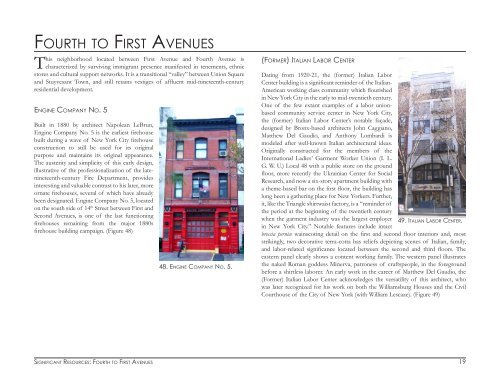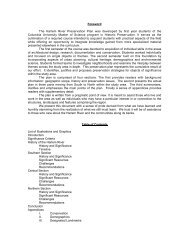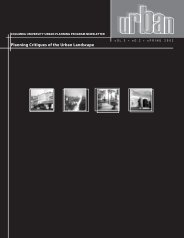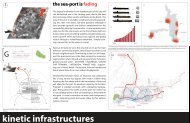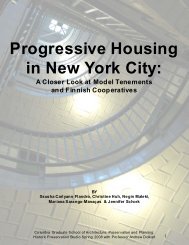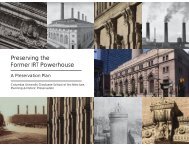14th street and union square preservation plan - Columbia ...
14th street and union square preservation plan - Columbia ...
14th street and union square preservation plan - Columbia ...
Create successful ePaper yourself
Turn your PDF publications into a flip-book with our unique Google optimized e-Paper software.
FOURTH TO FIRST AVENUES<br />
This neighborhood located between First Avenue <strong>and</strong> Fourth Avenue is<br />
characterized by surviving immigrant presence manifested in tenements, ethnic<br />
stores <strong>and</strong> cultural support networks. It is a transitional “valley” between Union Square<br />
<strong>and</strong> Stuyvesant Town, <strong>and</strong> still retains vestiges of affluent mid-nineteenth-century<br />
residential development.<br />
ENGINE COMPANY NO. 5<br />
Built in 1880 by architect Napolean LeBrun,<br />
Engine Company No. 5 is the earliest firehouse<br />
built during a wave of New York City firehouse<br />
construction to still be used for its original<br />
purpose <strong>and</strong> maintains its original appearance.<br />
The austerity <strong>and</strong> simplicity of this early design,<br />
illustrative of the professionalization of the latenineteenth-century<br />
Fire Department, provides<br />
interesting <strong>and</strong> valuable contrast to his later, more<br />
ornate firehouses, several of which have already<br />
been designated. Engine Company No. 5, located<br />
on the south side of 14 th Street between First <strong>and</strong><br />
Second Avenues, is one of the last functioning<br />
firehouses remaining from the major 1880s<br />
firehouse building campaign. (Figure 48)<br />
48. ENGINE COMPANY NO. 5.<br />
(FORMER) ITALIAN LABOR CENTER<br />
Dating from 1920-21, the (former) Italian Labor<br />
Center building is a significant reminder of the Italian-<br />
American working class community which flourished<br />
in New York City in the early to mid-twentieth century.<br />
One of the few extant examples of a labor <strong>union</strong>based<br />
community service center in New York City,<br />
the (former) Italian Labor Center’s notable façade,<br />
designed by Bronx-based architects John Caggiano,<br />
Matthew Del Gaudio, <strong>and</strong> Anthony Lombardi is<br />
modeled after well-known Italian architectural ideas.<br />
Originally constructed for the members of the<br />
International Ladies’ Garment Worker Union (I. L.<br />
G. W. U.) Local 48 with a public store on the ground<br />
floor, more recently the Ukrainian Center for Social<br />
Research, <strong>and</strong> now a six-story apartment building with<br />
a theme-based bar on the first floor, the building has<br />
long been a gathering place for New Yorkers. Further,<br />
it, like the Triangle shirtwaist factory, is a “reminder of<br />
the period at the beginning of the twentieth century<br />
when the garment industry was the largest employer 49. ITALIAN LABOR CENTER.<br />
in New York City.” Notable features include intact<br />
breccia pernice wainscoting detail on the first <strong>and</strong> second floor interiors <strong>and</strong>, most<br />
strikingly, two decorative terra-cotta bas reliefs depicting scenes of Italian, family,<br />
<strong>and</strong> labor-related significance located between the second <strong>and</strong> third floors. The<br />
eastern panel clearly shows a content working family. The western panel illustrates<br />
the naked Roman goddess Minerva, patroness of craftspeople, in the foreground<br />
before a shirtless laborer. An early work in the career of Matthew Del Gaudio, the<br />
(Former) Italian Labor Center acknowledges the versatility of this architect, who<br />
was later recognized for his work on both the Williamsburg Houses <strong>and</strong> the Civil<br />
Courthouse of the City of New York (with William Lescaze). (Figure 49)<br />
SIGNIFICANT RESOURCES: FOURTH TO FIRST AVENUES<br />
19


